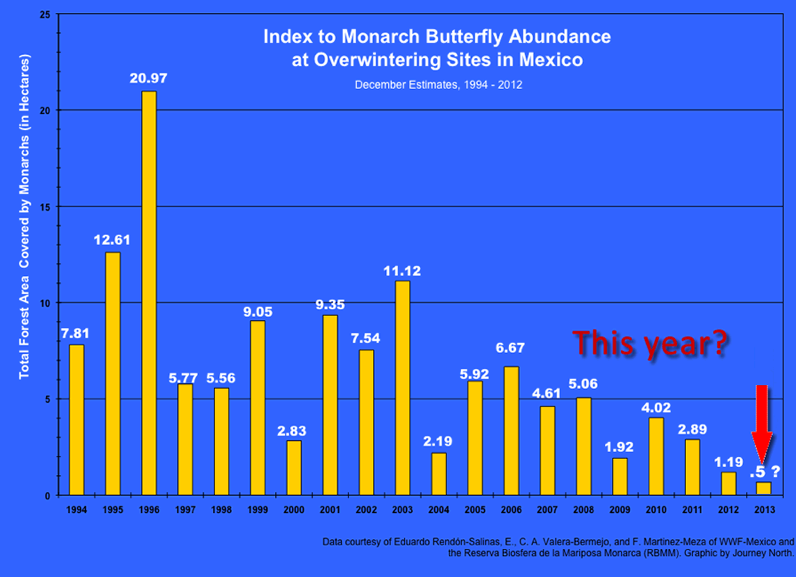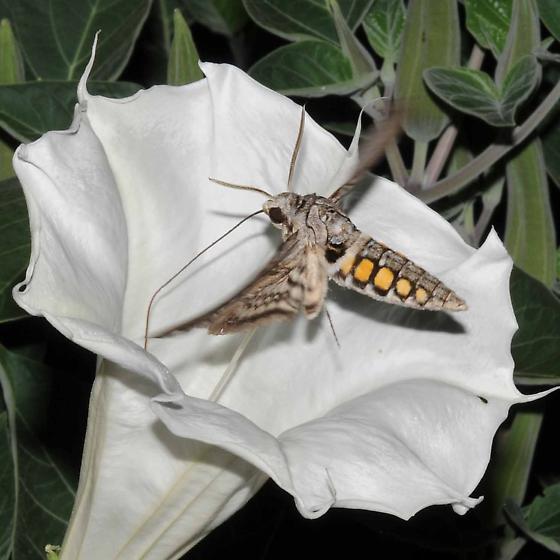We close out 2013 as a banner year at the Texas Butterfly Ranch. 2013 marked our third year covering the life cycle of butterflies, moths and the plants that sustain them. We published 35 posts this year and drew 107,000+ page views–up from 42,000 in 2012. Thanks to all for reading.
The decline of the Monarch butterfly migration led butterfly news this year, with a post detailing the steady downward spiral topping the list. Interestingly, posts about how-to-raise butterflies and what species of milkweed to plant also ranked highly–apparent responses to the severity of pollinator decline? Hmm.
Below, you’ll find the posts you enjoyed most in 2013.
Monarch butterflies in decline
Dire predictions became reality in November when news reports suggested that only three million Monarch butterflies would make it to Mexico this year. For the first time in recorded history, Monarch butterflies did not arrive at their ancestral roosts in Michoacán en masse by Day of the Dead, November 2. Scientists were concerned at this historic tardy turn.

Only three million Monarchs made it to Mexico and may occupy only 1.25 acres of forest this year, a record low. Graph via Journey North
The 2012 season, acknowledged as the worst year for the insects population wise, counted 60 million Monarchs. In prime years, they numbered 450 million. Looks like 2013 will hold the dubious distinction of the year the migration came unraveled.
Dr. Chip Taylor, founder of Monarch Watch, relayed a similar prognosis earlier in the season when he told the International Butterfly Breeders conference that the butterflies would likely occupy only 1.25 acres of forest in the mountainous roosting grounds west of Mexico City. At their height, the creatures roosted in 50+ acres of forest.

Dr. Chip Taylor visits with IBBA president Kathy Marshburn at the organization’s combined conference with the Association for Butterflies in November. Photo by Monika Maeckle
How unspeakably sad that the entire population of Monarch butterflies east of the Rocky Mountains could fit into a space smaller than a strip shopping center.
People are doing what they can to help Monarchs on the home front
Our two-part feature on How to Raise Monarch Butterflies at Home ranked a top post with readers. In April I wrote that I had collected Monarch eggs from milkweed in my front yard. Subsequent posts detailed step-by-step how easy it is to raise Monarch butterflies at home.

Monarch butterfly caterpillar on milkweed, its host plant. You can raise them at home–it’s easy! Photo by Monika Maeckle
We started with the eggs, watching them hatch and become tiny caterpillars. We fueled their growth with fresh, pesticide-free milkweed, then followed their whole lifecycle to the chrysalis stage and finally their eclosure to a butterfly. You can do it, too. Read the two-part series here.
Moths: Underappreciated, extremely interesting
While we call ourselves the Texas Butterfly Ranch, we try not to be speciesists. That is, we try not to give too much attention to one species over another—although that’s pretty much impossible given America’s love affair with the Monarch butterfly.
We agree that Monarchs and other butterflies seem to get all the press at the expense of their less celebrated, night flying cousins. That said, we try to spread the love around.
In fact, two of our top posts in 2013 didn’t even discuss butterflies. Instead, they profiled two of the more interesting moths you’ll likely find in your gardens.
This post on tomato hornworms ran back in June 2012, yet climbed easily into one of the top reads of 2013—18 months after it posted in the height of summer. Perhaps because so little is written about moths? Or maybe thanks to National Moth Week, a relatively new celebration launched by the Friends of the East Brunswick Environmental Commission (Friends of EBEC), a group of citizen scientists that focus on the fascinating flyers every summer. Mark your calendar for National Moth Week 2014, July 19 – 27, as a week that will celebrate their existence.
The truth is that even butterfly loving vegetable gardeners often squish the tomato and tobacco hornworms, which feast voraciously on tomato, pepper and potato plants and other members of the Solanaceae family. We encourage ceding a few fruits or entire plants to these dramatic caterpillars, which later morph into beautiful Sphinx Moths.
Then, our story on the mysterious, myth-laden Black Witch Moth: Large, Common, Bat-like, and Harmless drew lots of interest.
This “bat moth” resembles a bat in size and shape and its seven-inch wingspan ranks it as the largest moth in North America. Black Witch Moths are common in Central and South Texas and frequently rest under the eaves of houses near doors, often startling folks as they arrive home. Generous rains seem to have offered favorable conditions for them this year, as we had many questions about them.
The folklore surrounding these harmless nightflyers runs the gamut. They can be a harbinger of death–or a sign that your future includes a winning lottery ticket.
Butterfly 911: lack of host plant results in milkweed emergency
This post on a “milkweed emergency” drew plenty of views and the most comments of any post ever on the Texas Butterfly Ranch (76).
The quandary of too many caterpillars and no milkweed to feed them continues to find readers, especially at the end of the Monarch butterfly season when nurseries and gardens have exhausted their host plant supplies.

It takes a lot of milkweed to grow a Monarch butterfly. The caterpillars consume 200x their birth weight in milkweed leaves. Photo by Monika Maeckle
Every fall, we receive frantic emails, Facebook posts and even phone calls from people who have plenty of Monarch caterpillars, but no milkweed on hand. A milkweed shortage pretty much defines the plight of Monarch butterflies throughout the migration landscape.
Frequently, folks will run out to a nursery and buy a fresh pot of milkweed, unaware that plants have been sprayed with systemic pesticides, which can last six months. This post details how to avoid the sad experience of finding all your caterpillars dead from toxic poisoning the morning after you’ve served them polluted host plant.
How to Move a Monarch Chrysalis
If you can get your caterpillars to the chrysalis stage, they often will build their jade jewel in an inconvenient location. A post that draws steady interest year after year answers the frequently asked question: Is Relocating a Monarch Chrysalis OK?
The answer: yes, you may relocate the creatures once they make their chrysalis.
The post details a few tips on how to handle a Monarch chrysalis with care and do’s and don’ts for successfully relocating them.
Got Milkweed? Updated guide to Texas milkweeds
Finally, rounding out our top posts of 2013, an updated Milkweed Guide: Choose Best Plants for Monarch Butterflies. Given the news of the decline of the Monarch butterfly migration, the call to plant milkweed and other wildflowers to make sure pollinators—not just Monarchs—continue their life cycle becomes urgent.

Asclepias asperula, Antelope Horns Milkweed on Texas Hill Country roadside in April 2011, photo by Monika Maeckle
We get many questions in our emailbox regarding which species are best for San Antonio and Austin yards, ranches, or even a vacant lots that beg for a butterfly garden. Our Milkweed Guide aims to point you in the right direction.
We’ve added a few links below to other favorite posts that we believe merit your time. We hope they pique your interest. Let us know by leaving a comment.
To all our readers, mariposistas, MOTH-ers, butterfly lovers near and far–cheers to a healthy, happy 2014. Plant lots of wildflowers, host and pollinator plants in 2014. Stay away from pollutants and pesticides. Enjoy and tend your gardens and wildscapes.
See you outside.
More stories like this:
Like what you’re reading? Don’t miss a single post from the Texas Butterfly Ranch. Sign up for email delivery, like us on Facebook, or follow us on Twitter, @monikam.



